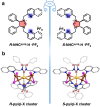Carbene-stabilized enantiopure heterometallic clusters featuring EQE of 20.8% in circularly-polarized OLED
- PMID: 37433775
- PMCID: PMC10336039
- DOI: 10.1038/s41467-023-39802-w
Carbene-stabilized enantiopure heterometallic clusters featuring EQE of 20.8% in circularly-polarized OLED
Abstract
Bright and efficient chiral coinage metal clusters show promise for use in emerging circularly polarized light-emitting materials and diodes. To date, highly efficient circularly polarized organic light-emitting diodes (CP-OLEDs) with enantiopure metal clusters have not been reported. Herein, through rational design of a multidentate chiral N-heterocyclic carbene (NHC) ligand and a modular building strategy, we synthesize a series of enantiopure Au(I)-Cu(I) clusters with exceptional stability. Modulation of the ligands stabilize the chiral excited states of clusters to allow thermally activated delayed fluorescence, resulting in the highest orange-red photoluminescence quantum yields over 93.0% in the solid state, which is accompanied by circularly polarized luminescence. Based on the solution process, a prototypical orange-red CP-OLED with a considerably high external quantum efficiency of 20.8% is prepared. These results demonstrate the extensive designability of chiral NHC ligands to stabilize polymetallic clusters for high performance in chiroptical applications.
© 2023. The Author(s).
Conflict of interest statement
The authors declare no competing interests.
Figures








Similar articles
-
Solution-Processable Chiral Boron Complexes for Circularly Polarized Red Thermally Activated Delayed Fluorescent Devices.ACS Appl Mater Interfaces. 2021 Oct 13;13(40):47826-47834. doi: 10.1021/acsami.1c13564. Epub 2021 Sep 29. ACS Appl Mater Interfaces. 2021. PMID: 34587742
-
Doping Copper(I) in Ag7 Cluster for Circularly Polarized OLEDs with External Quantum Efficiency of 26.7 .Angew Chem Int Ed Engl. 2025 Jan 27;64(5):e202417934. doi: 10.1002/anie.202417934. Epub 2024 Dec 12. Angew Chem Int Ed Engl. 2025. PMID: 39627994
-
Circularly Polarized Organic Light-Emitting Diode Based on Device Functional Layer Materials.Small. 2025 Feb;21(8):e2409541. doi: 10.1002/smll.202409541. Epub 2025 Jan 31. Small. 2025. PMID: 39887943 Review.
-
White Circularly Polarized OLEDs Enabled by Orthogonal Engineering of Achiral Thermally Activated Delayed Fluorescence Emitters and Chiral Assemblies.Angew Chem Int Ed Engl. 2025 Aug 17:e202516018. doi: 10.1002/anie.202516018. Online ahead of print. Angew Chem Int Ed Engl. 2025. PMID: 40820575
-
Luminescent Complexes of Platinum, Iridium, and Coinage Metals Containing N-Heterocyclic Carbene Ligands: Design, Structural Diversity, and Photophysical Properties.Chem Rev. 2023 Jan 11;123(1):230-270. doi: 10.1021/acs.chemrev.2c00206. Epub 2022 Oct 31. Chem Rev. 2023. PMID: 36315851 Review.
Cited by
-
Circularly polarized OLEDs from chiral plasmonic nanoparticle-molecule hybrids.Nat Commun. 2025 Feb 15;16(1):1658. doi: 10.1038/s41467-025-57000-8. Nat Commun. 2025. PMID: 39955278 Free PMC article.
-
Maximized circularly polarized luminescence from metal clusters accelerates chiral photopolymerization.Nat Commun. 2025 Jul 25;16(1):6848. doi: 10.1038/s41467-025-62232-9. Nat Commun. 2025. PMID: 40715148 Free PMC article.
-
Raising Near-Infrared Photoluminescence Quantum Yield of Au42 Quantum Rod to 50% in Solutions and 75% in Films.J Am Chem Soc. 2024 Oct 3;146(41):27993-7. doi: 10.1021/jacs.4c11703. Online ahead of print. J Am Chem Soc. 2024. PMID: 39360944 Free PMC article.
-
Tightly bonded excitons in chiral metal clusters for luminescent brilliance.Nat Commun. 2025 Feb 21;16(1):1867. doi: 10.1038/s41467-025-57209-7. Nat Commun. 2025. PMID: 39984514 Free PMC article.
-
Dual-quartet phosphorescent emission in the open-shell M1Ag13 (M = Pt, Pd) nanoclusters.Nat Commun. 2024 Jul 16;15(1):5962. doi: 10.1038/s41467-024-50289-x. Nat Commun. 2024. PMID: 39013901 Free PMC article.
References
-
- Li L-K, et al. Strategies towards rational design of gold(III) complexes for high-performance organic light-emitting devices. Nat. Photon. 2019;13:185–191. doi: 10.1038/s41566-018-0332-z. - DOI
-
- Lu J-J, et al. Pyridinylphosphorothioate-based blue Iridium(III) complex with double chiral centers for circularly polarized electroluminescence. J. Mater. Chem. C. 2021;9:5244–5249. doi: 10.1039/D1TC00832C. - DOI
Grants and funding
LinkOut - more resources
Full Text Sources
Miscellaneous

